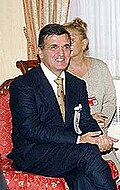President of the Federal Republic of Yugoslavia
| President of Serbia and Montenegro |
|
|---|---|

Standard of the President of
Serbia and Montenegro |
|
| Formation | 15 June 1992 |
| First holder | Dobrica Ćosić |
| Final holder | Svetozar Marović |
| Abolished | 3 June 2006 |
| Succession |
|
The President of Serbia and Montenegro (Serbian: Predsednik Srbije i Crne Gore) was the head of state of Serbia and Montenegro. From its establishment in 1992 until 2003, when the country was reconstituted as a confederacy (state union) via constitutional reform, the head of state was known as the President of the Federal Republic of Yugoslavia (Serbian: Predsednik Savezne Republike Jugoslavije). With the constitutional reforms of 2003 and the merging of the offices of head of government and head of state, the full title of the president was President of Serbia and Montenegro and Chairman of the Council of Ministers of Serbia and Montenegro (Serbian: Predsednik Srbije i Crne Gore i Predsednik Saveta ministara Srbije i Crne Gore). In 2006 the office was abolished as the state union was dissolved, with Serbia and Montenegro becoming independent countries.
As head of state, the President had the power to
In 2003, the powers of the president were extended to include the right to chair the Council of Ministers and propose the composition of the Council of Ministers to the parliament, effectively merging the powers of the head of government into the office.
From 1992 to 2000, the president was elected at the proposal of the President and Vice President of the Federal Assembly of Yugoslavia for a four-year term. After the constitutional amendments of 2000, direct elections for the office of President were introduced. After the constitutional reforms of 2003, the president was elected at the proposal of the President and Vice President of the Parliament of Serbia and Montenegro for a four-year term. The President of Serbia and Montenegro was a member of the Supreme Defence Council together with the President of Serbia and the President of Montenegro.
...
Wikipedia

